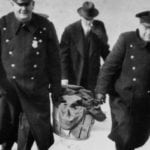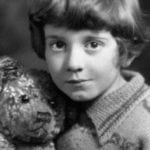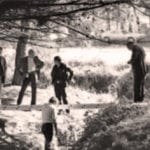 Mysteries
Mysteries  Mysteries
Mysteries  History
History 10 Surprising Stories About the Texas Rangers
 Humans
Humans 10 Philosophers Who Were Driven Mad by Their Own Theories
 Miscellaneous
Miscellaneous 10 Video-Game-Worthy Weapons and Armors from History
 Weird Stuff
Weird Stuff 10 Psychics Who Accurately Predicted Wartime Events
 The Arts
The Arts 10 Pieces of Art Inspired by a Broken Heart
 Health
Health 10 Science Fiction-Sounding New Medical Treatments
 History
History 10 Surprising Facts About the Father of Submarine Warfare
 Space
Space Ten Astonishing New Insights into Alien Worlds
 Weird Stuff
Weird Stuff 10 Bizarre Summer Solstice Rituals Still Practiced Today
 Mysteries
Mysteries Top 10 Haunting Facts About the Ghost Ship MV Alta
 History
History 10 Surprising Stories About the Texas Rangers
 Humans
Humans 10 Philosophers Who Were Driven Mad by Their Own Theories
Who's Behind Listverse?

Jamie Frater
Head Editor
Jamie founded Listverse due to an insatiable desire to share fascinating, obscure, and bizarre facts. He has been a guest speaker on numerous national radio and television stations and is a five time published author.
More About Us Miscellaneous
Miscellaneous 10 Video-Game-Worthy Weapons and Armors from History
 Weird Stuff
Weird Stuff 10 Psychics Who Accurately Predicted Wartime Events
 The Arts
The Arts 10 Pieces of Art Inspired by a Broken Heart
 Health
Health 10 Science Fiction-Sounding New Medical Treatments
 History
History 10 Surprising Facts About the Father of Submarine Warfare
 Space
Space Ten Astonishing New Insights into Alien Worlds
 Weird Stuff
Weird Stuff 10 Bizarre Summer Solstice Rituals Still Practiced Today
8 Harrowing Facts About The 9/11 Jumpers
Nearly two decades after the most devastating terrorist attacks in history, the most enduring images of September 11, 2001 seem set in stone. Smoke billowing from two of the world’s tallest towers. The live-TV horror of a second plane slamming into New York’s World Trade Center, eliminating any lingering hopes that the initial impact was an accident. Twin 110-story buildings imploding in heaps of ash and dust as thousands below ran for their lives.
See Also: 10 Disturbing Raw Videos From 9/11
But of the nearly 3,000 victims, approximately 200 – about 1 in every 15 deaths – died not from crashing planes, fanning flames or collapsing skyscrapers but by falling or jumping to certain death from the towers’ upper floors. Deemed too awful to air and too provocative to publish, the 9/11 jumpers have become the least confronted of the day’s victims, marginalized by society’s refusal to reckon with the unreckonable.
8 In the North Tower, the Jumpers Were Right in Assessing Their Fate
Of the 2,606 people who died in the attacks on the World Trade Center, more than half – at least 1,356[1] – were in the North Tower (Tower One) at or above the point of impact of American Airlines Flight 11, which slammed into the building at 8:46am. The South Tower (Tower Two) would be struck at 9:03am.
There are three reasons that the death toll was comparably high in the North Tower. First, since it was the first building impacted, those on high floors in the opposite tower had time to begin evacuating (more on that shortly). Second, the North Tower’s upper floors included the legendary Windows on the World[2] restaurant, which was hosting an event that morning attended by nearly 100 guests with more than 70 venue staff.
The third reason was both simple and tragic: no one above the impact zone in the North Tower had any chance whatsoever of surviving. Their fate was sealed by the plane, which wiped out all elevator shafts and staircases. The ensuing raging fire and all-encompassing smoke made any attempt at rooftop rescue via helicopter impossible. They were all doomed.
Most of the jumpers on 9/11 came from the North Tower – and they began falling just minutes after the plane’s impact. They had no exit and little choice, as temperatures in parts of the building rose to an estimated 1,000 degrees Fahrenheit. Some took to standing on desks because the floor was so hot.
Whether acting reflexively to intense heat or simply realizing there was no escape, the jumpers from the North Tower were only expediting the inevitable – one last act of control over the uncontrollable.
7 In the South Tower, Some May Have Had an Escape Route… But Didn’t Know It
In the South Tower (Tower Two), about 620 victims were at or above the point of impact of United Airlines Flight 175, which struck about 17 minutes after the North Tower crash. This precious time allowed many in the South Tower to evacuate, explaining why only half as many perished as in Tower One.
It also partially explains why there were far fewer jumpers from the South Tower. The other reason is that Flight 175 struck the South Tower considerably lower than Flight 11 hit the North Tower, meaning it would take longer for overwhelming heat to force many into so impossible a decision as to leap to certain death.
Still, no more than 18 people survived[3] who were at or above the point of impact, which ripped through the South Tower’s 78th floor Sky Lobby[4] where scores of people were awaiting transfer to express elevators down to the safety of the ground floor.
Unfortunately, far fewer should have died in the South Tower. For starters, many who began evacuating immediately following the North Tower impact were told to return to their desks.[5] Naturally, another impact was not anticipated.
Just as tragically is that one stairwell remained clear post-impact . . .[6] but very few people knew about it. We’ll never know for sure whether any of the South Tower jumpers had a realistic chance of reaching that stairwell, but others who perished when the building collapsed at 9:59am almost certainly could have made it out had they known.
6 Their Plight Was Too Terrible for Television
As the horror unfolded, television screens around the world filled with terrifying visuals. The North Tower’s upper floors engulfed in smoke, flames lapping from its gaping gash. The second plane’s impact sending a giant fireball[7] into the clear blue sky, instantly eliminating any hope that the first crash was an accident. Finally, the towers pancaking to the ground, half an hour apart, sending plumes of dust as tall as adjacent skyscrapers long dwarfed by the Twin Towers.
However, one image was too terrible for TV. As rumors of desperate jumpers reached NYC news anchors with cameras affixed on the burning towers, many—especially those broadcasting from nearby roofs or helicopters—could have zoomed in. They did not, choosing to inform viewers with sorrowful words rather than shocking close-ups.
Instead, most of the footage we have of the 9/11 jumpers comes from amateurs. One look leaves little wonder why newscasters decided against broadcasting the sorrowful spectacle. Many blessed themselves before their leap of faith. Some tried to make parachutes out of curtains or tablecloths. One man hopelessly tried to climb down the building.
This understandable modesty, however, had a long-lasting downside: Ten full years after 9/11, anniversary articles remarked how the jumpers had been “airbrushed from history”.[7] Besides the media’s reluctance to be deemed voyeuristic, another factor was the notion, however wrong, that the jumpers had committed a sort of circumstantial suicide rather than the plain reality that they, along with every other 9/11 victim, were simply murdered.
5 What They Were Jumping from Was Pure Hell

Several scientific studies explaining why the towers ultimately collapsed, including those exploring the thermodynamics of 9/11,[8] have been written. In layman’s terms, it was pure hell. The impacts of the planes sent an aviation fuel fireball through half a dozen levels of each tower, igniting desks, chairs, shelving, carpeting, work-space partitions, wall and ceiling panels, plastics of various kinds and, per the day’s macabre confetti, reams and reams of office paper.
The fires in some areas may have reached 800 degrees Celsius, yielding air temperatures impossible to fathom let alone survive. Thick, black smoke slowly choked people trapped on floors with exits jammed shut by the plane’s initial impact, or those in stairwells made entirely impassable from debris.
Humanizing the account are hundreds of phone calls[9] made from those trapped above the impact zones of both towers. As the situation went from bad to worse to hopeless, telephone calls to loved ones impotently watching on television showcase the panic as people fought to live. Many correctly weighed the deteriorating conditions in their blockaded offices against the likelihood of firefighters reaching them in time. Tom McGinnis, trapped on the 92nd floor of the North Tower, summed up the situation to his wife by saying “You don’t understand. There are people jumping from the floors above us.”
4 They Had a Long, Horrifying Way Down

The World Trade Center Towers were each approximately 1,300 feet tall – about one-quarter of a mile high. Even at speeds approaching 150mph,[10] the fall took approximately 10 seconds. Those 10 seconds were completely and utterly hopeless. They could see the crowds looking up and the ruined bodies of preceding jumpers. Some held hands and jumped in pairs, others stayed on their cell phones as they fell.[11]
One of the reasons the 9/11 jumpers leave so haunting a legacy is what their choice represents. If they chose to die by falling to their deaths from two of the world’s tallest buildings, we can only imagine how horrible it must have been inside those buildings.
This is evidenced by the confusion and denial at the ordeal’s inception. Many initially mistook the falling bodies for office furniture, perhaps hurled to smash a window for fresh air. Once it became unmistakable, we were horrified by what we saw – the jumpers, falling – in part because of what we couldn’t see – where and what they jumped from.
If this was their best option, what was their worst? This question is implied by the tribute statue honoring the jumpers[12] at New York/s 9/11 Memorial Museum, which was initially deemed too emotionally disturbing for public display.
3 One Fell on a Firefighter
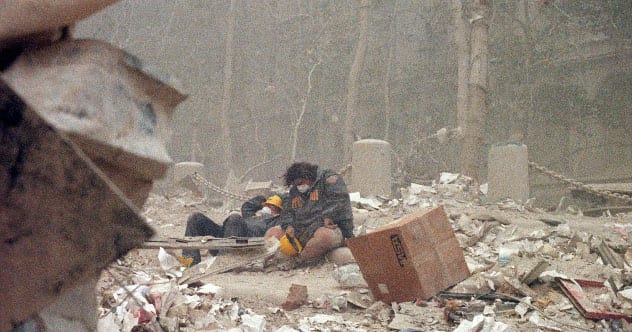
Of the 343 New York City Fire Department officials killed on 9/11, the very first documented fatality was 37-year-old Danny Suhr. He wasn’t killed by smoke inhalation or building collapse, but rather when a woman falling from the South Tower (Tower Two) fell directly on him.[13]
FDNY Captain Paul Conlon witnessed the entire incredible, heartbreaking spectacle: “It wasn’t like you heard something falling and could jump out of the way,” Conlon recalled. Suhr was just a few feet behind Conlon when the jumper landed on him. The impact was so violent that, in describing Suhr immediately afterward, Conlon said “it was as if he exploded.”[14]
In the type of tragic irony that often separated life from death that day, the incident likely saved Conlon’s life. By the time he was able to extract Suhr from the immediate vicinity, arrange for an ambulance (which was likely overly optimistic, but firefighters rarely leave men down) and begin back toward the South Tower… it was 9:59am. Tower Two came crumbling down. Conlon ran, successfully, for his life.
Throughout the ordeal, as firefighters formed makeshift command centers in the lobbies of both Towers, the jumpers crashing loudly outside were a constant reminder of both the urgency and hopelessness of the situation. That so many started up those endless flights of stairs nonetheless is a truly remarkable act of bravery.
2 A Jumper Was the Subject of a Highly Controversial Photo
The most famous image of a 9/11 jumper was taken by Pulitzer Prize-winning photographer Richard Drew. Simply called “The Falling Man”,[15] the photo depicts an adult male, head over feet with a light dress shirt fluttering in descent, against the backdrop of the unmistakable steel-slatted World Trade Center facade. Amid the fire and wreckage off-camera, the Falling Man is disturbingly serene.
After running in several newspapers on September 12, 2001, the photo generated such an uproar – many found it exploitative and intrusive – that it largely disappeared for several years. Drew once called the image “the most famous photo no one has seen”.[16]
The image’s relative obscurity ended in 2006 with the release of a documentary called “9/11: The Falling Man”.[17] Among other revelations, the film shows that the man was not diving straight down in the image’s eerily peaceful pose; rather, as shown by other photos in the series, he was in the throes of a violent, twisting tumble.
The film also posited an educated guess about who the Falling Man is. Most believe it was Jonathan Briley,[18] a 43-year-old audio technician for Windows on the World restaurant. A major clue was an orange tee shirt[19] visible in one photo of the series.
1 The Jumpers Were Given Unfair Stigmas… Even by Families of Victims
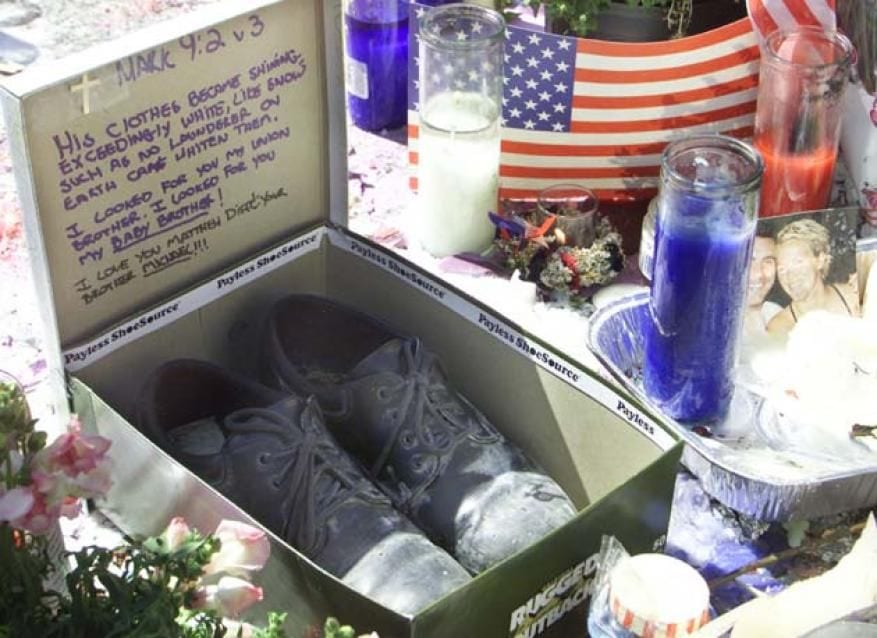
Any reasonable assessment of 9/11 concludes those who jumped from the Twin Towers were, along with everyone else who died, homicide victims. Unfortunately, the notion that jumpers were somehow “less than” those who perished from plane crashes, smoke, fire, or building collapse persisted in the tragedy’s aftermath.
For some, it was a matter of religious interpretation disavowing those who participate in their own death, regardless the impossible circumstances the jumpers’ faced. One victim’s daughter, confronted with the possibility that the famous Falling Man photo might depict her dad, angrily said “That piece of s— is not my father.”[20] (She was correct; her father didn’t own an orange tee shirt, which became an important identifying clue.)
However, other family members sought closure in determining precisely how a loved one perished that day. One grieving fiancée, Richard Pecorella,[21] spent untold hours scouring the Internet, poring through the troves of photographs and videos taken during and immediately following the terrorist attacks. In 2004, he found a photo of a group of people desperately peering from gaping holes high in the North Tower. One woman fit the description of his fiancée, Karen Juday,[22] including her outfit that day.
Sometime later, Pecorella came across a photo showing what seemed to be the same woman plummeting down, headfirst. As horrifying as the photo is, he said it provided some amount of peace.
For more lists like this, see 10 Heroic Police Officers Who Gave Their Lives on 9/11, and 10 Famous People Who Avoided Death on 9/11.
About The Author: Christopher Dale writes on society, politics and sobriety-based issues, and has been published in The Daily Beast, NY Daily News and Parents.com, among other outlets. Follow him on Twitter @ChrisDaleWriter.



